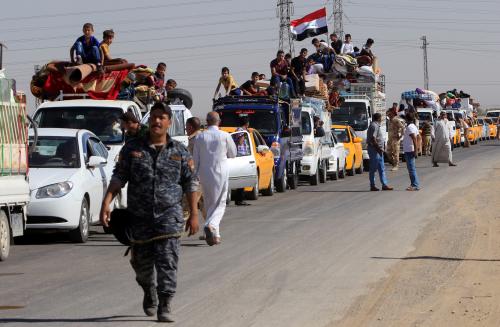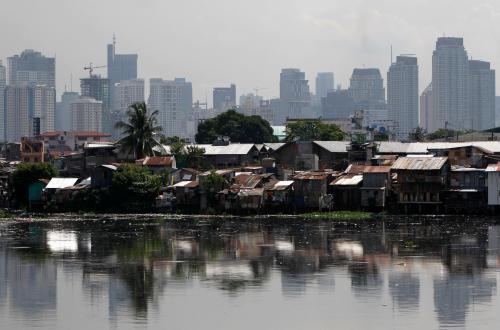Civil wars have changed. During the Cold War, most intrastate conflicts ended when one party completely defeated its enemy. With undisputed military victories, winners took all and dominated the policy space. By contrast, since 1990, only a fifth of all finalized civil wars ended in clear victories; others were either negotiated away or they simply died out. Why? Changing attitudes of international actors, along with evolving norms of conflict resolution, are among the factors.
Better prospects for negotiated solutions motivated a search for new policies for post-conflict recovery, a “development-for-peace” approach. From 2003 onward, the World Bank, the United Nations, and the European Union employed a joint Recovery and Peacebuilding Assessment (RPBA) to help identify, prioritize, and sequence recovery and peacebuilding activities. The RPBA has become the primary vehicle that informs the post-conflict recovery agenda globally, with more than 10 applications so far, including those in Eastern Ukraine and Northeast Nigeria.
At the core of RPBA lies a comprehensive damage and needs assessment, which utilizes on-the-ground interviews and surveys (also remote-sensing technology if needed) to rapidly assess people’s needs, priority interventions, and associated costs, all subject to risk and resilience dynamics. For quick solutions to immediate problems, these tools are indispensable. However, for informing medium-term economic recovery strategies, they need to be supplemented by economic analysis. Specifically, two issues make this a necessity.
- Infrastructure damages identify the infrastructure that was in place before the conflict and was damaged by it. This does not tell us if rebuilding a specific piece of infrastructure makes economic sense or not.
- Needs assessments show the current needs of a specific group of people at a specific location. But those people may move in response to a policy intervention.
In both cases, going from facts to policies is impeded by a missing piece of information. That is how people would react to different incentives created by a given intervention. This is an economic problem at its core.
For instance, some displaced people may choose to remain at their destination. In such a case, their welfare can be more effectively restored by other means (transfers, subsidies, or new infrastructure) than by repairing the damaged infrastructure at the origin.
Similarly, targeting people’s needs is more challenging when they can move. The spatial economics literature provides ample examples of how wage subsidies in less developed areas could eventually be captured by landlords (i.e., subsidies attract workers from other regions, which increases rents and reaps the subsidy from workers). Thus, place-based interventions need to be evaluated simultaneously across regions—which underlies the idea of “equilibrium” in economics.
To illustrate these points, we present a simplified version of the models used to analyze the economic impact of the conflict in Syria and the return of Syrian refugees. At the beginning (first panel), there are two identical regions, each producing 100 units of goods, named “coins” for simplicity, with wages set at 7 coins.
Figure 1. A simple example of post-conflict recovery policies with migration
Source: Author
Then, an unforeseen conflict in Region A cuts capital stock and total factor productivity down by half and lowers wages (second panel). In response, workers can move to Region B, which lowers wages there and increases them in Region A. Because the move itself costs 2 coins, workers move until the wage gap between the two regions falls just below 2 coins (otherwise, the next worker would also move). In the end, 68 percent of the workers in Region A move, and wages are stabilized at 4 coins in Region A and 6 coins in B. Overall, GDP in region A collapses to 18.4 coins and that in Region B increases to 143.7 coins.
Next, compare two alternative policies: rebuild the destroyed capital stock in Region A or invest the same resources in Region B. In the former case (third panel), wages in Region A increase to 4.9 coins—not enough to attract people from elsewhere. By comparison, investing in Region B (fourth panel) attracts more workers from Region A. In the end, the latter policy delivers a greater combined GDP (166.3 coins vs. 183.6 coins, respectively) and average wages (5.8 coins vs. 6.4 coins). Even the average wages of those original people in Region A, who are spread over two regions, is better in the latter case (4.2 coins vs. 6.2 coins). Reconstructing the damaged infrastructure is not the best option in this example.
The main point of this simple example is not that investing in one place or another must always be better. On the contrary, many factors, including mobility costs and the socioeconomic characteristics of regions, can influence this choice. The following factors, for instance, would change the results of this exercise:
- Migration restrictions. Additional migration to region B may not be feasible, politically. This is especially likely if regions denote separate countries (as opposed to displacement within a country).
- Non-monetary factors. People may have non-monetary attachments to places on cultural, ethnic, or sectarian grounds. In such cases, policies in Region A would carry greater welfare weights.
- Other policy options. This example considers a location selection problem for investments; there are other policy options. For instance, in the third panel, the same resources could be given to workers in Region A as cash transfers instead: Each worker would get 1.6 coins, boosting their incomes to 5.6 as opposed to 4.9 under reconstruction.
In general, to design post-conflict recovery policies, we need to consider all relevant factors simultaneously across different regions—that is by taking into consideration interregional interactions. This is where economic principles can help.
At the moment, the economic aspects of designing post-conflict recovery policies are underutilized. However, this can change with some effort. There are low-hanging fruits in this regard: streamlining economic methodologies (e.g., the linkages between RPBA outputs and formal models) and delivering a more accessible exposition of economic analysis to avoid a “black box” perception can go a long way. This requires a concerted effort among the institutions leading the post-conflict recovery agenda; but, the payoffs to such policy refinements would dwarf their costs.
The Brookings Institution is committed to quality, independence, and impact.
We are supported by a diverse array of funders. In line with our values and policies, each Brookings publication represents the sole views of its author(s).









Commentary
Wanted: Economic principles for post-conflict recovery
February 16, 2021